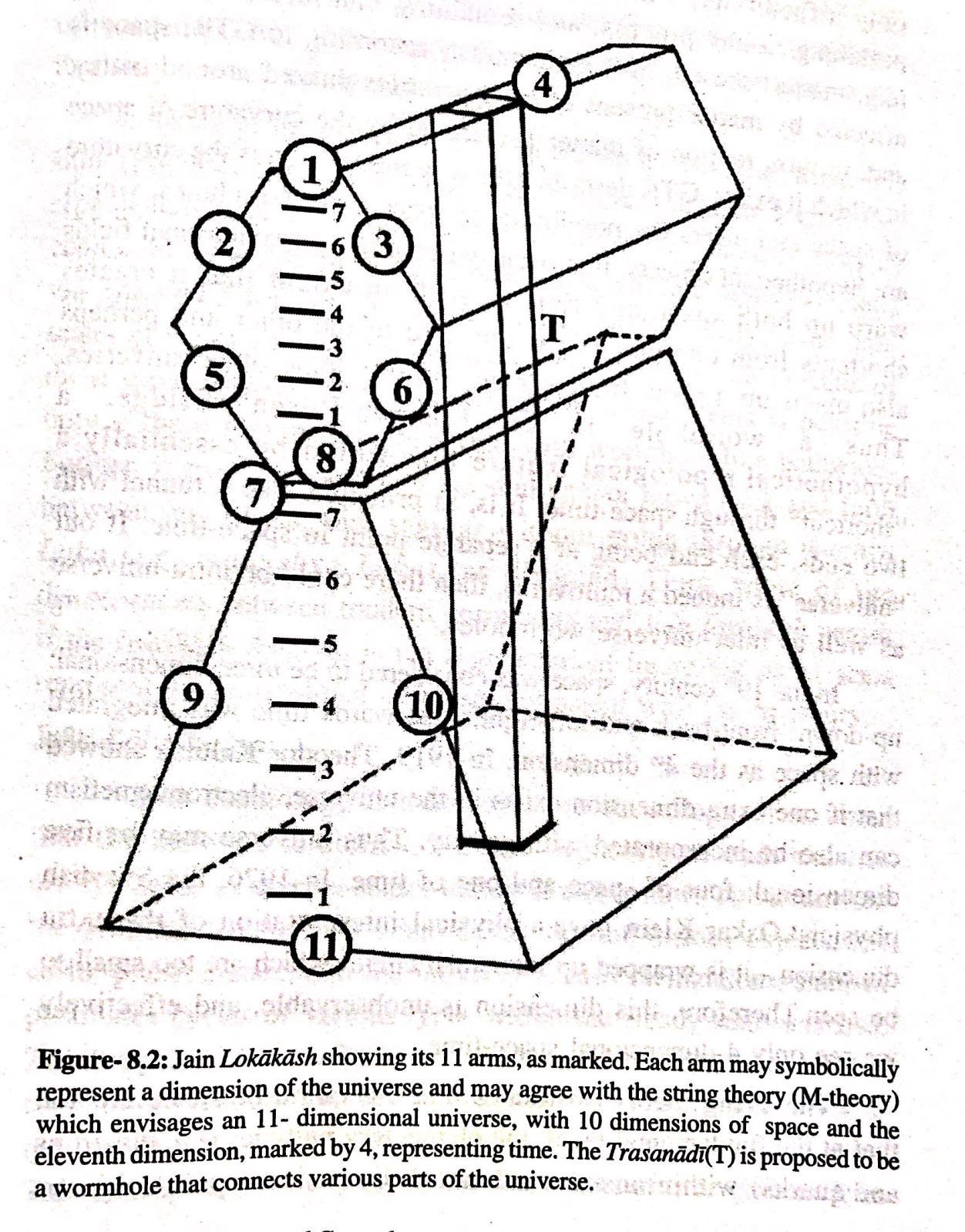Jain Science and Spirituality
by Medhavi Jain | 2020 | 61,419 words
This essay studies the elements of Jainism and investigates how Jain science and philosophy can give the world answers to through science and spirituality. Instead of interpreting it as a confined, strict philosophy, it is shown that Jainism represents a path towards self-awakening through self-improvement....
4.2. Universe in Jain Philosophy
‘The shape of the Jain universe (loka) is very particular. Jain lokakasha is schematically portrayed as a hexagon laying on an upset cone shaped segment with a level base having a limited thickness, as appeared in the picture underneath. Different parts, from top down, are called siddha shila (space of purity), expressed to be the dwelling place siddhas, urdhvaloka (heavenly abode of devas), madhyaloka (abode of humans, animals and other living beings), and adholoka (hell) individually. Both urdhvaloka and adholoka, each are subdivided into 7 prominent locales, as set apart by slender lines. In addition there is trasanadi interfacing the highest point of Loka to the base, most of the way along the profundity of loka as appeared in the picture.’[1]
Trasanadi depicts that all life forms, be it of heavens, hells or humans, animals, plants, birds and other creatures; reside in the limited boundary of it, though even that is beyond our imagination.
And beyond that what pervades is alokakasa or supracosmic space.
‘In old knowledge, objects were comprehended and disclosed with reference to the human body. The Jain convention considered the possibility of Loka Purusha so as to clarify human body. The universe just as human body were partitioned by them into three sections: the upper, the centre and the lower.’[2]
When one keenly observes the map of the universe (according to Jainism) and tries to relate it to our own body by asking the questions: why our body is like the way it is? Why, and how, humans are the best species of the planet? One speculates the following answers respectively: the shape and structure of our body represents the map of the universe. Being the best developed species each human represents a universe in himself, where the lower part (the part below the belly where reproductive and excretory organs are located) represents the adholoka. The middle part (of the body) i.e. stomach, kidneys, liver, lungs etc. represents the madhya loka (because of which all are wandering into the infinite cycles of birth and death), where the naval, being the centre of our body, represents the Meru (the exact centre of the universe). And the upper part i.e. the location of heart and mind and also the brain (according to Jain philosophy), that represents the urdhvaloka and finally the uppermost part of brain, that represents the siddhashila or the place of purest souls. That is why the brain is located on the topmost realm of our bodies for it has the capability to know and achieve the absolute in the cosmos.
And even the top-centre of the brain, which is called the Crown Chakra or Sahasrara Cakra, is the exact location to be focused as the Siddha shila.
‘The Crown Chakra is the focal point of all-inclusive love and shows as the will to serve others and the will to cherish. It is the focal point of profound cognizance and celestial unity. The Crown Chakra is known as the 'cosmic consciousness'. It is likewise the focal point of selfacknowledgment.’[3]
In today’s world when a large number of humans are venturing into the understanding of meditation and importance of the chakras, it is feasible to read and understand the ancient texts also.
Sometimes this seems silly to try to prove the text from the ancient scriptures right, through comparing it with modern science, as it makes so much sense that the mind says, ‘go on and believe it.’ But being humans we are not supposed to believe anything without using our rational faculty, which itself is very limited. However when a scientist ventures into the same, things become different.
Dr. Narender Bhandari, (More Information about Dr. Narendra Bhandari at www.nbhandari.com) in his book ‘Jainism: The Eternal and Universal Path to Enlightenment’ says,
‘We are constrained to take the view that this diagram does not speak of the shape, but some other element of the universe.' He estimates couple of potential outcomes in setting of understanding between such a structure and present day cosmology: 'It is hard to draw a multidimensional article on a two-dimensional paper. The sketch of Jain lokakasha (underneath) might be a projection of a four (or 11) dimensional article on a 2 dimensional paper.’

[Figure: Structure of the Universe according to the Jain Scriptures[4] —Jain Lokakash [lokakasha] showing its 11 arms, as marked. Each arm may symbolically represent a dimension of the universe and may agree with the string theory (M-theory) which envisages an 11-dimensional universe, with 10 dimensions of space and the eleventh dimension, makred by 4, representing time. The Trasanadi (T) is proposed to be a wormhole that connects various parts of the universe.]
Footnotes and references:
[1]:
JEUPE. pp. 139
[2]:
MBM. pp. 112
[3]:
https://www.worldpranichealing.com/en/chakra/sahasrara/ (Retrieved on 10-01-2018 @ 12:30 PM)
[4]:
JEUPE. pp. 141
